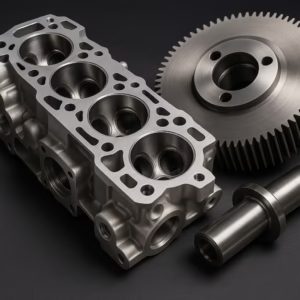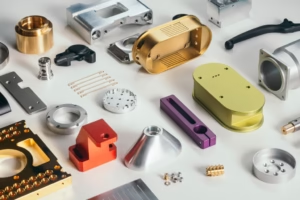Blog Details

Beste staal voor machinale bewerking - een handleiding van Prototek
Verspanen is een cruciaal aspect van de productie-industrie, en de keuze van het juiste staal is van het grootste belang om het succes van het productieproces te garanderen. In deze uitgebreide gids van Prototek gaan we dieper in op de belangrijkste factoren bij het selecteren van het meest geschikte staal voor verspanende toepassingen.
Basiseigenschappen van staal
Sterkte en hardheid: one of the most fundamental properties of steel is its strength and hardness. Strength indicates the ability of a material to resist deformation and destruction, while hardness reflects the ability of a material to resist external pressure. In machining, the selection of appropriate strength and hardness of steel is the key to ensuring the durability and performance stability of parts.
Taaiheid en plasticiteit: Taaiheid verwijst naar het vermogen van staal om te weerstaan aan scheuren door schokken of trillingen, terwijl plasticiteit verwijst naar het vermogen van een materiaal om te vervormen zonder te breken tijdens de verwerking. Voor onderdelen die schokbelastingen moeten weerstaan of complexe vormen vereisen, is staal met een goede taaiheid en plasticiteit essentieel.
Corrosiebestendigheid: De corrosiebestendigheid van staal bepaalt de prestaties ervan in ruwe omgevingen. Vooral in natte of chemisch corrosieve omgevingen kan corrosiebestendig staal de levensduur van onderdelen verlengen en de onderhoudskosten verlagen.
Staalclassificatie
Koolstofstaal:
Hoog Koolstofstaal: hoog koolstofgehalte, hoge hardheid, geschikt voor snijgereedschappen en onderdelen met hoge sterkte.
Medium Koolstofstaal: gemiddeld koolstofgehalte, met goede sterkte en plasticiteit, veel gebruikt bij de productie van machineonderdelen.
Laag koolstofstaal: relatief laag koolstofgehalte, gemakkelijk te verwerken, gebruikt voor lassen en de productie van onderdelen die plasticiteit vereisen.
Gelegeerd staal:
Chroomlegeringsstaal: bevat chroom om de hardheid en corrosiebestendigheid te verbeteren, geschikt voor de productie van snijgereedschappen en lagers.
Wolfram gelegeerd staal: bevat wolfraam, dat de snijprestaties en slijtvastheid verhoogt, en wordt gebruikt in snijgereedschappen met hoge snelheid.
Nickel alloy steel: nickel-containing, excellent corrosion resistance and high-temperature stability, suitable for chemical and aviation fields.
Andere categorieën:
Roestvrij staal: uitstekende corrosiebestendigheid voor toepassingen waarbij uiterlijk en duurzaamheid vereist zijn.
Gereedschapsstaal: ontworpen om gereedschap te maken met een hoge hardheid en slijtvastheid.
Verenstaal: heeft een goede elasticiteit en vermoeiingssterkte, voor de vervaardiging van veren en elastische onderdelen.
Belangrijkste elementen van machinale bewerking
Cutting performance: in the machining process, cutting performance is one of the key factors. This involves the reaction of steel undercutting with a tool, including friction and heat generation between the tool and the workpiece. The selection of steel with good cutting performance can improve machining efficiency, reduce tool wear, and ensure the stability of the machining process.
Heat Treatment Adaptability: The heat Treatment Adaptability of steel refers to its performance changes after high-temperature treatment. In machining, some parts need to undergo heat treatment to improve their hardness, strength, and other properties. Therefore, the selection of steel with good adaptability to heat treatment is the key to ensuring the final product quality.
Machining stability: the machining stability of steel is related to the stability and controllability of the machining process. Some steels may cause dimensional inconsistency or shape distortion due to deformation or instability during processing. Therefore, it is very important to select steel with good machining stability to ensure the machining of high-precision parts.
Het meest geschikte staal voor machinale bewerking
Drilling: recommended steel: high-speed steel with good machinability and wear resistance, such as M2 high-speed steel.
Milling: recommended steel: alloy steel suitable for milling, such as AISI 4140 alloy steel, with good machinability and strength.
Turning: recommended steel: easy to process low carbon steel, such as AISI 1018 low carbon steel, suitable for turning and surface processing.
High-speed cutting: recommended steel: Tungsten alloy steel with high hardness and machinability, such as Tungsten Carbide.
Welding: recommended steels: easy-to-weld low-carbon structural steels, such as AISI 1020, for welded structural components.
Corrosion resistance requirements: recommended steel: stainless steel, such as AISI 316, with good corrosion resistance, suitable for chemical and marine environments.
Praktische toepassingen en casestudies
Onderdelen met hoge sterkte in de ruimtevaart:
Toepassing: productie van onderdelen voor vliegtuigmotoren, zoals turbinebladen.
Steel selection: use nickel base alloy steel, such as the Inconel series, to ensure that the parts are at high temperatures, in a high-pressure environment with good strength and corrosion resistance.
Motoronderdelen in de automobielindustrie:
Toepassing: vervaardiging van de krukas van een automotor.
Staalselectie: selecteer gelegeerd staal met een hoog koolstofgehalte, zoals AISI 4340, om een uitstekende sterkte en slijtvastheid te verkrijgen, zodat de krukas bij hoge belasting uitstekende prestaties levert.
Productie van gereedschap:
Toepassing: productie van snijgereedschappen met hoge snelheid, zoals frezen.
Staalselectie: gebruik hogesnelheidsstaal, zoals M2, om ervoor te zorgen dat het gereedschap goede snijprestaties en slijtvastheid heeft, geschikt voor hogesnelheidstoepassingen.
Corrosion-resistant components in chemical equipment:
Application: manufacturing corrosion-resistant linings in chemical reactors.
Steel selection: stainless steel, such as AISI 316L, to ensure that parts are in a corrosive chemical environment with good corrosion resistance.
Structurele onderdelen van werktuigmachines:
Toepassing: productie werktuigmachine bed.
Staalselectie: gebruik structureel gelegeerd staal, zoals AISI 4140, om goede sterkte en snijprestaties te verkrijgen, om de stabiliteit en duurzaamheid van de machinestructuur te garanderen.
Oppervlaktebehandeling van onderdelen:
Application: the production of high-surface quality parts, such as motorcycle crankshaft surfaces.
Steel selection: choose easy-to-process low-carbon steel, such as AISI 1045, to ensure the stability and accuracy of surface processing.
To select suitable steel for machining needs to consider the properties, classification of steel, and the factors of the machining process. Through in-depth understanding and practical application verification, manufacturers can improve production efficiency, reduce costs, and produce high-quality products. Future development will focus on the development of new materials and the application of more intelligent machining technology to promote the progress of manufacturing.
Neem contact met ons op via e-mail als u iets nodig hebt: Lynnyao@prototekparts.com of bel: +86-0792-86372550
Tags:
- Staal voor machinale bewerking
























































